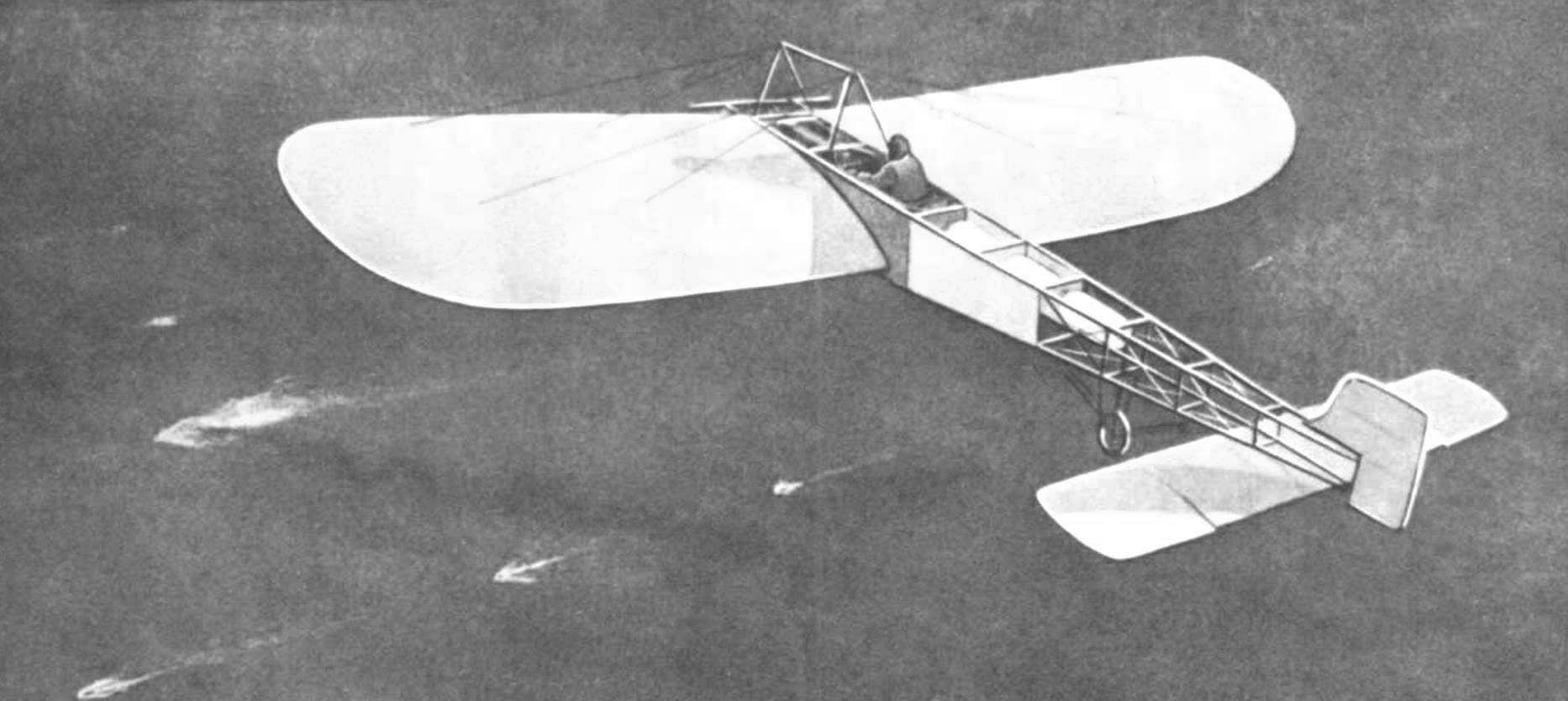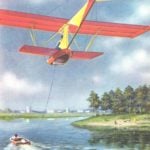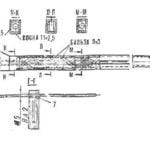 Any machine is not born suddenly starts with something more simple. It happened with the plane-monoplane. Its forerunner was destined to become a flying model. Was 1887. Professor of physics and astronomy, scientific Secretary of the Smithsonian scientific Institute of Washington Samuel Pierpont Langley was seriously interested in issues of flying heavier than air. Having done a series of aerodynamic experiments to test model wings for vertical installation — “revolving machine” Langley was engaged in the construction of flying models. But first, he carefully studied everything that was already reached before him, in particular flying models are heavier than air, which were built in 70-ies in France. At that time the greatest success in model experiments reached the Frenchman Alphonse Peno, first to use rubber motor for rotating the propeller of a model aircraft, and Austrian Wilhelm Kress.
Any machine is not born suddenly starts with something more simple. It happened with the plane-monoplane. Its forerunner was destined to become a flying model. Was 1887. Professor of physics and astronomy, scientific Secretary of the Smithsonian scientific Institute of Washington Samuel Pierpont Langley was seriously interested in issues of flying heavier than air. Having done a series of aerodynamic experiments to test model wings for vertical installation — “revolving machine” Langley was engaged in the construction of flying models. But first, he carefully studied everything that was already reached before him, in particular flying models are heavier than air, which were built in 70-ies in France. At that time the greatest success in model experiments reached the Frenchman Alphonse Peno, first to use rubber motor for rotating the propeller of a model aircraft, and Austrian Wilhelm Kress.
Model A. Peno “PLANFOR” had one wing, he was placed horizontal tail and, finally, the pusher propeller. Model V. Kress had two wings, were placed one after another. Behind the rear edge of the second wing had two pusher propeller, and behind them a horizontal and vertical stabilizer.
In Paris V. Kress demonstrated flying his twin-engine models, in which the propellers rotated from withing the rubber. But in 1876, working in St. Petersburg, he started flying model airplanes in the hall of one of the then centres of scientific thought of the Russian capital — in the Salt town on the banks of the Fontanka river.
I must say that at the same time with V. Kress worked to create flying models of aircraft and our compatriot Alexander Mozhaysky. In 1876 he successfully showed in Kronstadt flying his model with a spring motor. Nine years later, in 1885, under the scheme of A. F. Mozhaysky builds and tests the world’s first airplane.
In the late 80-ies of C. L. Langley, repeating in the U.S. experiences with flights Paris rezinomotornaya models emphasizes the model of Kress. However, the results of experiments do not satisfy the American Professor, as the rubber motor allows to achieve a long flight. He tries to adapt to the model of a pneumatic motor, but to no avail, because his work is too short. Finally after nine years of hard work, 1896, Langley creates a suitable “model” engine — steam engine, weighing 464, Along with the watertube boiler full weight of the entire propulsion system was 2.9 kg. the Engine develops a power of 1 HP at steam pressures up to 10.5 ATM.
The engine was installed on the fifth under the account model built by Langley. Flying weight it reached 11 kg. the Previous four models fly poorly due to excessively heavy steam engine, but the fifth acted in the air perfectly.

For reproductions of the paintings of that time depict the moments of flight before landing in Dover (England). Left — the medal is engraved in the memory of momentous flights.
For the last of its model Langley chose the layout of wings, propellers and tail almost the same as V. Kress on his rezinomotornaya models. Only the wings it was rectangular and not like a bird, as in the model of the Austrian. The model had the fuselage truss assembled from thin steel tubes. Fastened to it one after another two rectangular wings, which had considerable cross “V”, each with span 4220 mm in length of the entire apparatus 4660 mm. Behind the rear wing housed the tail, consisting of the stabilizer and fin. Steam engine located in the fuselage, rotated two propellers with a diameter of 1200 mm at a speed of 1200 rpm. Its model called the Langley “Aerodrome”. Note that at that time there were no concepts like “airplane” or “airplane”. The model was launched with a special catapult, which consisted of the guide rails and the springs, letting her push at the time of the derailment. Catapult mounted on a barge, standing at the shore of the Potomac river, which hosted the experiments.
This is how the flight model in a letter to the French Academy of Sciences, the inventor of the telephone Graham bell accidentally present at the launch: “the Airfield” went straight up against the wind and moved with remarkable stability circles with a diameter of about 90 meters, continuously elevating: after about a minute and a half in height, which I thought was equal to about 30 meters, screws stopped, and to my surprise, the car did not fall, but gently slipped into the water, which it struck no blow so that immediately can resume the experience.” Bell’s letter ended with the words: “it seems to Me that any man that being present at this interesting sight, would have seen the possibility of flight in the air by mechanical means.”
The message is immediately effective: a large number of fans of Aeronautics, as it was then called aviation, keenly interested in models of Langley. In the September issue of the French magazine “Aeronaut” for 1896 published information about the experiments of Langley and the device it models.

“PLANFOR” A. Peno — first flying model airplane, steadily to keep in the air.

Flying model B. Kress.

“Airfield”, P Langley.

The participants of the second model aircraft competitions (1907) Polan and burden.
In the early twentieth century in Europe and in the United States was keen on building biplanes — airplanes with two pairs of wings, placed one above the other. The feasibility of this scheme was confirmed by experiments with box kites were first constructed and is widely used by Australian L. Hargraves at the end of the last century. However, the success of the flight models, Langley was forced to pay attention to the scheme of the aircraft with two pairs of wings located in the same plane.
When and where on the planet held the first competitions of aeromodellers? This is today, few people know. And it happened in the summer of 1905 in France. Aviation Commission of the Aero club of France organized the first contest of flying models. The winner of the in it was Louis Pare with his model glider, flying 131 m and performed according to the scheme used Langley.
In that distant time, among the many who have worked hard to create a flying machine heavier than air, was a mechanic the Frenchman Louis Bleriot. He began with the construction in 1903, an “Artificial bird” — the ornithopter, which was not up in the air. Subsequent machines, the second, third and fourth — it represented a aircraft, but the awesome configuration. However, they only podpravili, and did not take off and very soon were broken or falling apart.
In 1907, after another failure with the plane-monoplane, built like a duck with a wing having bent back ends, blériot decided to use a schema-flying model Langley for their fifth machine. That idea gave him the success of such schemes not only first, but second competition model airplanes organized by the French Aero club in 1907. The first two places were taken by Polan and burden with models of gliders, which had two pairs of rectangular wings, located in the same plane one behind the other, as a model Langley.
Note that the winner of the first aircraft modeling competitions Pare worked with Louis Bleriot as a mechanical engineer. In all likelihood, this circumstance has played some role in the selection Bleriot scheme for his fifth machine.
The wingspan of the aircraft was 5850 mm length 6000 mm, gross weight — 280 kg, the engine had a capacity of 24 HP and rotated the pulling air screw. It blériot flew with a length of 143 m at altitude 12 m.


It was the first flight success of the designer. After some modifications of the apparatus Bleriot flies on it already 186 m at a height of 15 m. Further modification of his plane, essentially copied from Langley models, primarily to reduce the span of the rear wing, the introduction of the control system of the apparatus deflected control surfaces. Much in the same control surfaces used on modern aircraft, i.e. the elevators, rudders and ailerons. However PA its eleventh aircraft instead of Aileron Bleriot used (by analogy with the apparatus of the Wright brothers), the skewed surface of the wings. So was built sequentially machine “Bleriot VIII”, “blériot VIII-bis” and “blériot XI”.
“Blériot VIII-bis” a constructor for the first time on 30 October 1908 carries flight on the closed route from one city to the other with return in one day from Turin to Arena spaced from each other at a distance of 14 km.
Eight months later, on July 25, 1909, Bleriot first men to fly the aircraft over the water — the English channel between England and France. It was an exceptional event the first steps of aviation. This curiously describes himself flights of Louis Bleriot.
“True to his custom, I got up only when the sun appeared above the horizon. Black smoke minonoski “Escape” appointed to accompany me, eclipsing the sun. Soon, however, my escort stays behind. I’m flying. Feel like a balloon so the atmosphere is still quiet. It seems that I am very slowly moving forward. This is probably due to the monotony of the situation. For ten minutes I am completely alone, lost in the foaming sea, not seeing any points on the horizon, not a single boat on the water. But the silence around, broken only by the roaring of the engine fraught with serious danger.
Conscious of this, I’m not keeping my eyes on benzenamine and pointer oil flow. Those ten minutes seemed terribly long, and, in truth, I felt really happy when I noticed the grey bar that appeared before me in the sea. There was no doubt: it was the English shore. My plane dutifully obey the management and approaching the steep Bank Only… hell, I don’t see Dover! Where are we? Notice three of the ship… Obviously, they are in port. I quietly follow them. The sailors greeted me with enthusiastic shouts and gestures. Finally, shown on the right of the coastal bend, and shortly later Dover castle.
I am seized with a wild joy. I turn toward the shore and I see there is a man, I desperately waving tricolor French flag. Down below, recognized the familiar editor. One among the great plains, he hoarse shouting something to me. I want to sit down, but the wind swinging the airplane.
It’s been thirty-three minutes, as I in the air. This is more than enough, still more not to tempt fate. Risking to crash, I turn off the ignition and flop down on the ground. The chassis of the airplane bursting and podrumyanitsya. Nothing can be done! But I now successfully flew across the English channel”.
It was exactly 70 years ago. After the famous flight, the plane “Bleriot XI,” became a role model in the work of many other designers.
In the workshops Bleriot this device, called “Traverse the English channel” (“Crossed channel”), built in series in the period 1909-1912 years.
Here are some technical data of this plane. The scope of his wing was 8700 mm, length — 7200 mm, wing area — 14,1 m2, gross weight — 305 kg. engine “Anzani” capacity 25 HP, the plane developed a speed of 70 km/h.




The first flights immediately attracted the attention of journalists and artists. These humorous pictures taken from Russian, French and German postcards late XIX — early XX century (from the collection of the Leningrad engineer O. N. Zakharova).
About 20 copies of “blériot XI” Russia imports — military Department, national flying club and private individuals. On one of them after finalization of the machines in the workshops of the Aero club in 1911, Russian pilot Alexander Vasiliev made a flight from St. Petersburg to Moscow.
Lived whether the “Bleriot” to the present day, survived if at least one of them? Yes, they exist. The original copy of “Traverse channel” preserved in the National aeroasia Fraction. In aeroasia in the Polish city of Krakow on display “blériot XI”, re-built an old pilot I. Zolotov. One of the series of “blériot XI” is stored in the Museum of the history of technology in the city of Detroit (USA).
In the future scheme of the plane “Bleriot XI” was successfully developed and was used by many companies and individual designers in the creation of new aircraft in the period 1912-1914 years. The most famous of them — Nieuport, Moran, Deperdussin (France), Bristol (England), C-9, C-11, C-12 (Russia).
So, the monoplane scheme, born from successful experiments with flying models, has won a strong place in the development of aircraft 70 years ago.



